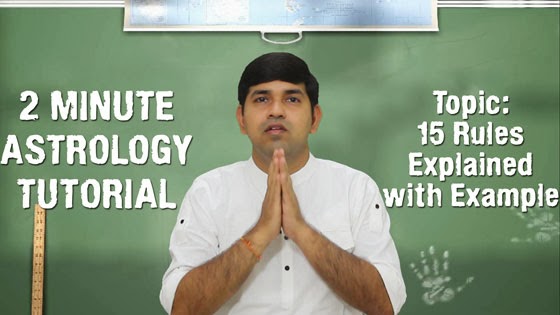(If you missed the Part-23 of ‘2 Minutes Astrology Tutorial’, click here: Learn Astrology In 2 Minutes - Part-23)
हिंदी में पढ़ने के लिए यहाँ क्लिक करें
We had discussed about “dispositor theory” in our episode about Raja Yoga. It is an important principle and astrologers usually make mistake while using it. According to this principle, strength of a planet depends mostly on the lord of the sign it is posited in; e.g. a planet is exalted, but it is posited in a sign whose lord is debilitated or weak due to some other reason. In such a case, this exalted planet will not be able to give good results as per its own potential. It’s a very important theory and should not be ignored. The power of a planet can never be determined without analyzing its dispositor. In certain situations, this principle becomes even more important; especially in such a case when many planets are posited in a sign.
Take a look at this illustration. In this chart, Jupiter, Venus and Mercury are posited in first house and in Leo sign. According to astrology, benefic planets are even better if posited in Kendra. It’s a strong Raja Yoga. However, it should be noted that all these planets are posited in Leo, and the Sun, lord of this sign, is in 12th house. It cannot be a good position for any planet. Also, this Sun is conjoining with debilitated Mars and being aspected by enemy Saturn. Therefore, dispositor Sun is very weak. This weak Sun is ruining Raja Yoga for Jupiter, Venus and Mercury.
Similarly, we should not neglect this principle while analyzing exalted and debilitated planets. The underlying principle for ‘Neecha Bhanga Raja Yoga’ is also this dispositor theory. If Sun is exalted in a birth-chart, i.e. it is posited in Aries, first of all we should analyze the strength of Mars. If Mars, being dispositor of Sun, is weak; the Sun will not be able to give results of being exalted.
This table is showing what planets to focus while determining the effects of an exalted or a debilitated planet:
Planet
|
If Exalted
|
If Debilitated
|
Sun
|
Mars
|
Venus
|
Moon
|
Venus
|
Mars
|
Mars
|
Saturn
|
Moon
|
Mercury
|
--
|
Jupiter
|
Jupiter
|
Moon
|
Saturn
|
Venus
|
Jupiter
|
Mercury
|
Saturn
|
Venus
|
Mars
|
I hope you enjoyed the video. Namaskar!
You can subscribe to our exclusive collection of videos on astrology, Yoga, and spirituality. To subscribe, please click here -
By Astrologer Punit Pandey
Find all the notes of upcoming parts here:















